Evaluation the Performance of Three Types of Two-Source Evapotranspiration Models in Urban Woodland Areas
Abstract
1. Introduction
2. Materials and Methods
2.1. Study Area
2.2. In Situ Measurements
2.2.1. ET Flux Measurements
2.2.2. Stable Isotope Observation
2.2.3. Environmental Variables Observations
2.3. Shuttleworth–Wallace Model
2.4. FAO Dual-Kc Model
2.5. Deep Neural Networks
2.6. Model Operation and Evaluation
3. Results and Analysis
3.1. Meteorological and Flux Footprint Variations over the Two Stations
3.2. Performance Evaluation of Three Classic Evapotranspiration Models
3.3. Sensitivity of Three Types of Two-Source ET Models to Input Variables
4. Discussion
4.1. Characteristics of Three Types of Two-Source ET Models
4.2. Selection of Three Classic Evapotranspiration Models
4.3. Uncertainty in the Model Comparison Analysis
5. Conclusions
- (1)
- The flux footprint observed using the urban EC towers varied widely across different test days. Therefore, the simulation of urban ET should consider the impact of flux footprint on the measured ET. In addition, due to the higher LAI, the observed ET of the Yangmeikeng site was higher than that of the Tianxinshan site;
- (2)
- For the simulation of urban ET and T/ET at both main urban and suburban EC stations, the DNN model performed best, followed by the S-W model, and the FAO dual-Kc model. For the ET simulation, the R2 and RMSE were 0.73 and 0.74 mm/day, 0.71 and 0.75 mm/day, and 0.69 and 0.81 mm/day for the DNN, S-W, and FAO dual-Kc models, respectively. For the T/ET simulation, the R2 and RMSE were 0.81 and 0.17, 0.78 and 0.19, and 0.75 and 0.25 for the DNN, S-W, and FAO dual-Kc models, respectively;
- (3)
- For the three classic evapotranspiration models, Ta was the most important input variable and was extremely sensitive to the simulated urban ET. On the contrary, u was the least sensitive to simulating ET; hence, the u can be excluded from the input dataset in subsequent urban ET studies;
- (4)
- The error of the DNN model mainly comes from the simulation of extreme ET. The error of the S-W model lies in the determination of impedance parameters, and the uncertainty of the FAO dual-Kc model is the determination of vegetation coefficients;
- (5)
- When there is a large number and multiple types of meteorological, soil, and vegetation datasets available, the DNN model is recommended. When there are multiple types of meteorological, soil, and vegetation datasets available but the number of observation data is relatively smaller, the S-W model is recommended. When there are fewer types of input variables available, the FAO dual-Kc model is recommended to simulate urban ET and its components.
Author Contributions
Funding
Institutional Review Board Statement
Informed Consent Statement
Data Availability Statement
Conflicts of Interest
References
- Bosch, J.M.; Hewlett, J.D. A review of catchment experiments to determine the effect of vegetation changes on water yield and evapotranspiration. J. Hydrol. 1982, 55, 3–23. [Google Scholar] [CrossRef]
- Shukla, J.; Mintz, Y. Influence of land-surface evapotranspiration on the earth’s climate. Science 1982, 215, 1498–1501. [Google Scholar] [CrossRef] [PubMed]
- Küçüktopcu, E.; Cemek, E.; Cemek, B.; Simsek, H. Hybrid Statistical and Machine Learning Methods for Daily Evapotranspiration Modeling. Sustainability 2023, 15, 5689. [Google Scholar] [CrossRef]
- Sheng, H.P.; Fadzil, L.M.; Manickam, S.; Al-Shareeda, M.A. Vector Autoregression Model-Based Forecasting of Reference Evapotranspiration in Malaysia. Sustainability 2023, 15, 3675. [Google Scholar]
- Sutanto, S.J.; Wenninger, J.; Coendersgerrits, A.; Uhlenbrook, S. Partitioning of evaporation into transpiration, soil evaporation and interception: A combination of hydrometric measurements and stable isotope analyses. Hydrol. Earth Syst. Sci. Discuss. 2012, 9, 3657–3690. [Google Scholar]
- Qiu, G.Y.; Li, C.; Yan, C. Characteristics of soil evaporation, plant transpiration and water budget of Nitraria dune in the arid Northwest China. Agric. For. Meteorol. 2015, 203, 107–117. [Google Scholar] [CrossRef]
- Hussain, S.; Mubeen, M.; Nasim, W.; Fahad, S.; Ali, M.; Ehsan, M.A.; Raza, A. Investigation of Irrigation Water Requirement and Evapotranspiration for Water Resource Management in Southern Punjab, Pakistan. Sustainability 2023, 15, 1768. [Google Scholar] [CrossRef]
- Rai, P.; Kumar, P.; Al-Ansari, N.; Malik, A. Evaluation of Machine Learning versus Empirical Models for Monthly Reference Evapotranspiration Estimation in Uttar Pradesh and Uttarakhand States, India. Sustainability 2022, 14, 5771. [Google Scholar] [CrossRef]
- Novotná, B.; Jurík, Ľ.; Čimo, J.; Palkovič, J.; Chvíla, B.; Kišš, V. Machine Learning for Pan Evaporation Modeling in Different Agroclimatic Zones of the Slovak Republic (Macro-Regions). Sustainability 2022, 14, 3475. [Google Scholar] [CrossRef]
- Kuang, W. 70 years of urban expansion across China: Trajectory, pattern, and national policies. Sci. Bull. 2020, 65, 1970–1974. [Google Scholar] [CrossRef]
- Tong, S.; Prior, J.; McGregor, G.; Shi, X.; Kinney, P. Urban heat: An increasing threat to global health. BMJ 2021, 375, n2467. [Google Scholar] [CrossRef] [PubMed]
- Piroozfar, P.M.; Farr, E.; Pomponi, F. Urban heat island (uhi) mitigating strategies: A case-based comparative analysis. Sustain. Cities Soc. 2015, 19, 222–235. [Google Scholar]
- Chen, H.; Jiang, A.Z.; Huang, J.J.; Li, H.; McBean, E.; Singh, V.; Zhang, J.; Lan, Z.; Gao, J.; Zhou, Z. An enhanced shuttleworth-wallace model for simulation of evapotranspiration and its components. Agric. For. Meteorol. 2022, 313, 108769. [Google Scholar] [CrossRef]
- Chen, H.; Huang, J.J.; McBean, E.; Dash, S.S.; Li, H.; Zhang, J.; Lan, Z.; Gao, J.; Zhou, Z. Evapotranspiration partitioning based on field-stable oxygen isotope observations for an urban locust forest land. Ecohydrology 2022, 15, e2431. [Google Scholar] [CrossRef]
- Kuang, W.; Zhang, S.; Li, X.; Lu, D. A 30 m resolution dataset of China’s urban impervious surface area and green space, 2000–2018. Earth Syst. Sci. Data 2021, 13, 63–82. [Google Scholar] [CrossRef]
- Narita, K.I.; Nishikawa, T. Measurement of Sensible Heat Flux in an Urban Area by Eddy-Correlation Method. In Summaries of Technical Papers of Meeting Architectural Institute of Japan D; Architectural Institute of Japan: Tokyo, Japan, 1995. [Google Scholar]
- Timmermans, W.J.; Kustas, W.P.; Anderson, M.C.; French, A.N. An intercomparison of the Surface Energy Balance Algorithm for Land (SEBAL) and the Two-Source Energy Balance (TSEB) modeling schemes. Remote Sens. Environ. 2007, 108, 369–384. [Google Scholar] [CrossRef]
- Guzinski, R.; Anderson, M.C.; Kustas, W.P.; Nieto, H.; Sandholt, I. Using a thermal-based two source energy balance model with time-differencing to estimate surface energy fluxes with day–night MODIS observations. Hydrol. Earth Syst. Sci. 2013, 17, 2809–2825. [Google Scholar] [CrossRef]
- Shuttleworth, W.J.; Wallace, J.S. Evaporation from sparse crops-an energy combination theory. Q. J. R. Meteorol. Soc. 1985, 111, 839–855. [Google Scholar] [CrossRef]
- Evett, S.R.; Lascano, R.J. ENWATBAL.BAS: A mechanistic evapotranspiration model written in compiled basic. Agron. J. 1993, 85, 763–772. [Google Scholar] [CrossRef]
- Kustas, W.P.; Norman, J.M. Evaluation of soil and vegetation heat flux predictions using a simple two-source model with radiometric temperatures for partial canopy cover. Agric. For. Meteorol. 1999, 94, 13–29. [Google Scholar] [CrossRef]
- Sauer, T.; Norman, J.; Tanner, C.; Wilson, T. Measurement of heat and vapor transfer coefficients at the soil surface beneath a maize canopy using source plates. Agric. For. Meteorol. 1995, 75, 161–189. [Google Scholar] [CrossRef]
- Wang, P.; Yamanaka, T.; Li, X.-Y.; Wei, Z. Partitioning evapotranspiration in a temperate grassland ecosystem: Numerical modeling with isotopic tracers. Agric. For. Meteorol. 2015, 208, 16–31. [Google Scholar] [CrossRef]
- Wu, Y.; Du, T.; Ding, R.; Tong, L.; Li, S.; Wang, L. Multiple methods to partition evapotranspiration in a maize field. J. Hydrometeorol. 2017, 18, 139–149. [Google Scholar] [CrossRef]
- Chen, H.; Huang, J.J.; McBean, E. Partitioning of daily evapotranspiration using a modified shuttleworth-wallace model, random forest and support vector regression, for a cabbage farmland. Agric. Water Manag. 2019, 228, 105923. [Google Scholar] [CrossRef]
- Feng, Y.; Gong, D.; Mei, X.; Cui, N. Estimation of maize evapotranspiration using extreme learning machine and generalized regression neural network on the China Loess Plateau. Hydrol. Res. 2017, 48, 1156–1168. [Google Scholar] [CrossRef]
- Patil, A.P.; Deka, P.C. An extreme learning machine approach for modeling evapotranspiration using extrinsic inputs. Comput. Electron. Agric. 2016, 121, 385–392. [Google Scholar] [CrossRef]
- Zanetti, S.S.; Sousa, E.F.; Oliveira, V.P.S.; Almeida, F.T.; Bernardo, S. Estimating evapotranspiration using artificial neural network and minimum climatological data. J. Irrig. Drain. Eng. 2007, 133, 83–89. [Google Scholar] [CrossRef]
- Nourani, V.; Paknezhad, N.J.; Tanaka, H. Prediction Interval Estimation Methods for Artificial Neural Network (ANN)-Based Modeling of the Hydro-Climatic Processes, a Review. Sustainability 2021, 13, 1633. [Google Scholar] [CrossRef]
- Fan, J.; Yue, W.; Wu, L.; Zhang, F.; Cai, H.; Wang, X.; Lu, X.; Xiang, Y. Evaluation of SVM, ELM and four tree-based ensemble models for predicting daily reference evapotranspiration using limited meteorological data in different climates of China. Agric. For. Meteorol. 2018, 263, 225–241. [Google Scholar] [CrossRef]
- Mehr, A.D.; Haghighi, A.T.; Jabarnejad, M.; Safari, M.J.S.; Nourani, V. A new evolutionary hybrid random forest model for SPEI forecasting. Water 2022, 14, 755. [Google Scholar] [CrossRef]
- Yang, F.; White, M.; Michaelis, A.; Ichii, K.; Hashimoto, H.; Votava, P.; Zhu, A.-X.; Nemani, R. Prediction of continental-scale evapotranspiration by combining MODIS and ameriflux data through support vector machine. IEEE Trans. Geosci. Remote Sens. 2006, 44, 3452–3461. [Google Scholar] [CrossRef]
- Allen, R.G. Crop evapotranspiration-guidelines for computing crop water requirements. FAO Irrig. Drain. Pap. (FAO) 1998, 56, D05109. [Google Scholar]
- Er-Raki, S.; Chehbouni, A.; Guemouria, N.; Ezzahar, J.; Khabba, S.; Boulet, G.; Hanich, L. Citrus orchard evapotranspiration: Comparison between eddy covariance measurements and the FAO-56 approach estimates. Plant Biosyst. 2009, 143, 201–208. [Google Scholar] [CrossRef]
- Chen, H.; Huang, J.J.; McBean, E.; Singh, V.P. Evaluation of alternative two-source remote sensing models in partitioning of land evapotranspiration. J. Hydrol. 2021, 597, 126029. [Google Scholar] [CrossRef]
- Hu, X.; Shi, L.; Lin, G.; Lin, L. Comparison of physical-based, data-driven and hybrid modeling approaches for evapotranspiration estimation. J. Hydrol. 2021, 601, 126592. [Google Scholar] [CrossRef]
- Jiang, S.Z.; Liang, C.; Zhao, L.; Gong, D.; Huang, Y.; Xing, L.; Zhu, S.; Feng, Y.; Guo, L.; Cui, N. Energy and evapotranspiration partitioning over a humid region orchard: Field measurements and partitioning model comparisons. J. Hydrol. 2022, 610, 127890. [Google Scholar] [CrossRef]
- Mauder, M.; Foken, T.; Clement, R.; Elbers, J.; Kolle, O. Quality control of carboeurope flux data? part ii: Inter-comparison of eddy-covariance software. Biogeosci. Discuss. 2007, 4, 451–462. [Google Scholar]
- Göckede, M.; Foken, T.; Aubinet, M.; Aurela, M.; Banza, J. Quality control of carboeurope flux data—Part 1: Coupling footprint analyses with flux data quality assessment to evaluate sites in forest ecosystems. Biogeosciences 2008, 5, 433–450. [Google Scholar] [CrossRef]
- Davis, R.; Huntley, A.; Costa, D.; Worthy, G.; Castellini, M. Assessment of steady and non-steady state fuel homeostasis using the constant isotope infusion method. Minerva Radiol. Fisioter. E Radiobiol. 1987, 6, 28–37. [Google Scholar]
- Yuan, Y.; Du, T.; Wang, H.; Wang, L. Novel Keeling-plot-based methods to estimate the isotopic composition of ambient water vapor. Hydrol. Earth Syst. Sci. 2020, 24, 4491–4501. [Google Scholar] [CrossRef]
- Muoz-Sabater, J.; Dutra, E.; Agustí-Panareda, A.; Albergel, C.; Arduini, G.; Balsamo, G.; Boussetta, S.; Choulga, M.; Harrigan, S.; Hersbach, H.; et al. Era5-land: A state-of-the-art global reanalysis dataset for land applications. Earth Syst. Sci. Data 2021, 13, 4349–4383. [Google Scholar] [CrossRef]
- LuisMerlin, O.-G.; SalahKhabba, O.-R.; Maria, S.E. Estimating the water budget components of irrigated crops: Combining the fao-56 dual crop coefficient with surface temperature and vegetation index data. Agric. Water Manag. 2018, 208, 120–131. [Google Scholar]
- Paredes, P.; D’Agostino, D.; Assif, M.; Todorovic, M.; Pereira, L.S. Assessing potato transpiration, yield and water productivity under various water regimes and planting dates using the fao dual kc approach. Agric. Water Manag. 2018, 195, 11–24. [Google Scholar] [CrossRef]
- Chiew, F.; Kamaladasa, N.N.; Malano, H.M.; McMahon, T.A. Penman-Monteith, FAO-24 reference crop evapotranspiration and class-A pan data in Australia. Agric. Water Manag. 1995, 28, 9–21. [Google Scholar] [CrossRef]
- Sharma, G.; Singh, A.; Jain, S. A hybrid deep neural network approach to estimate reference evapotranspiration using limited climate data. Neural Comput. Appl. 2021, 33, 8017. [Google Scholar]
- Atilla, Z.; Yamaç, S.S. Modelling of daily reference evapotranspiration using deep neural network in different climates. arXiv 2020, arXiv:2006.01760. [Google Scholar]
- Pino-Vargas, E.; Taya-Acosta, E.; Ingol-Blanco, E.; Torres-Rúa, A. Deep Machine Learning for Forecasting Daily Potential Evapotranspiration in Arid Regions, Case: Atacama Desert Header. Agriculture 2022, 12, 1971. [Google Scholar] [CrossRef]
- Lee, B.; Kim, N.; Kim, E.-S.; Jang, K.; Kang, M.; Lim, J.-H.; Cho, J.; Lee, Y. An artificial intelligence approach to predict gross primary productivity in the forests of South Korea using satellite remote sensing data. Forests 2020, 11, 1000. [Google Scholar] [CrossRef]
- Jarvis, P.G. The interpretation of the variations in leaf water potential and stomatal conductance found in canopies in the field. Philos. Trans. R. Soc. Lond. B Biol. Sci. 1976, 273, 563–610. [Google Scholar] [CrossRef]
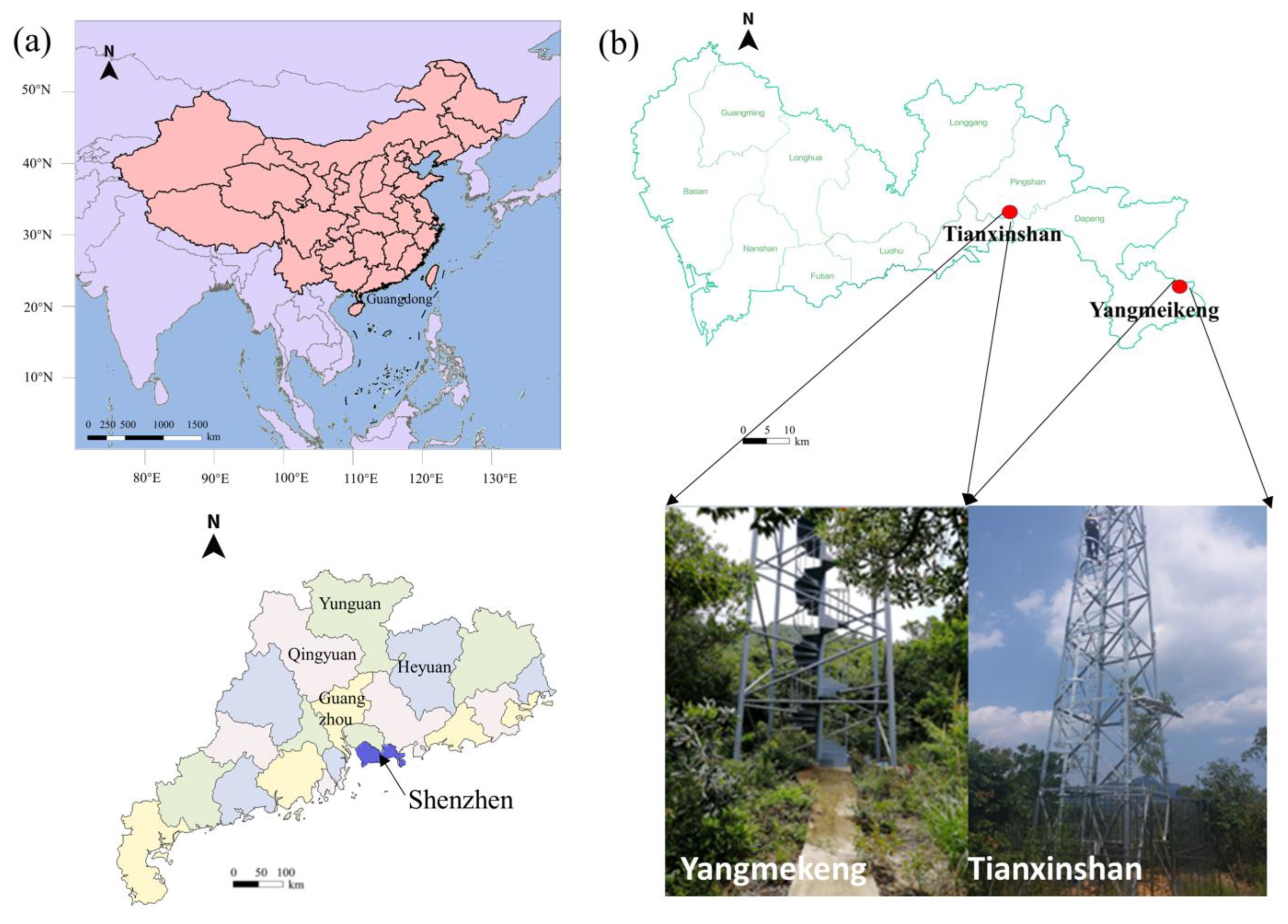

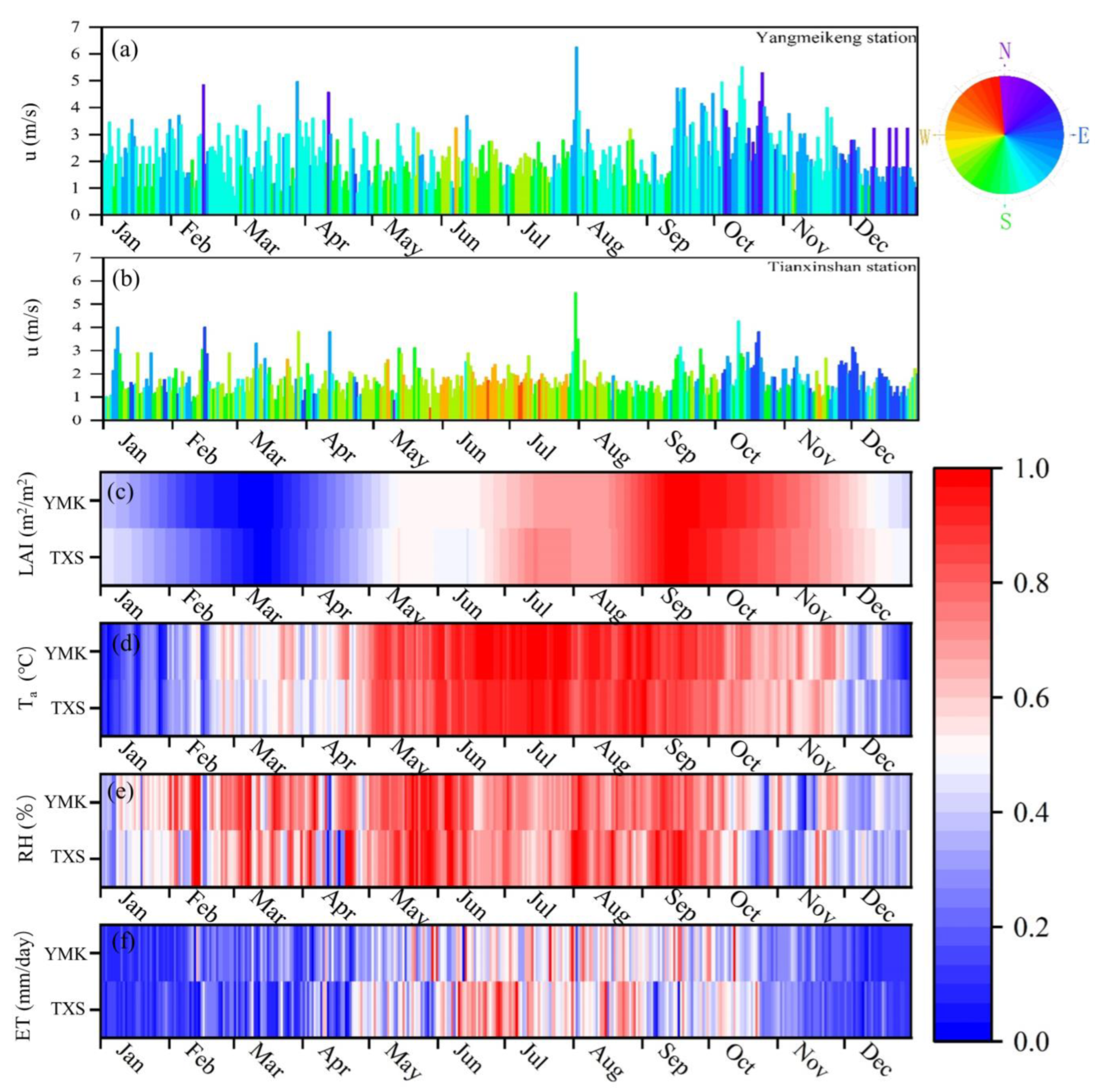
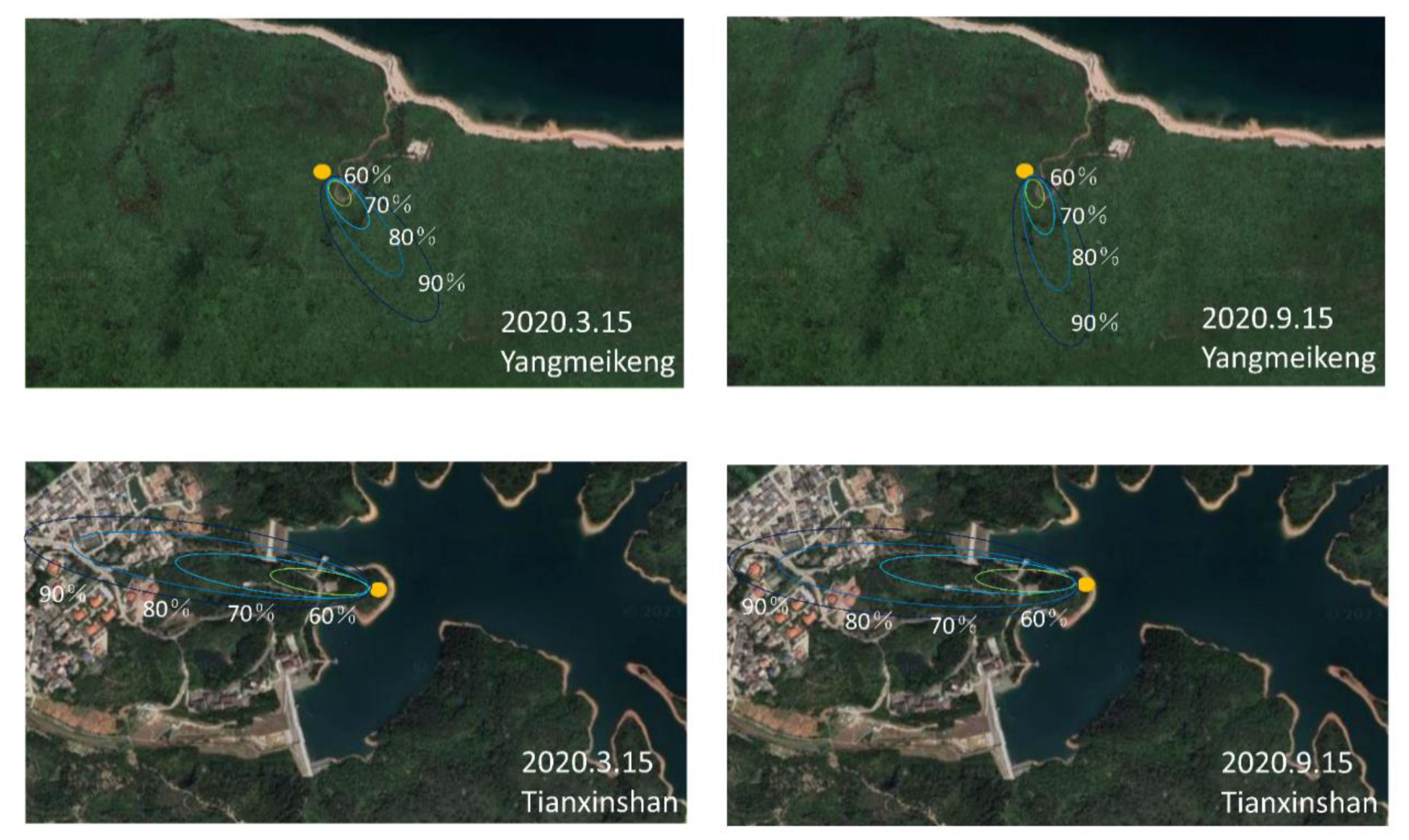
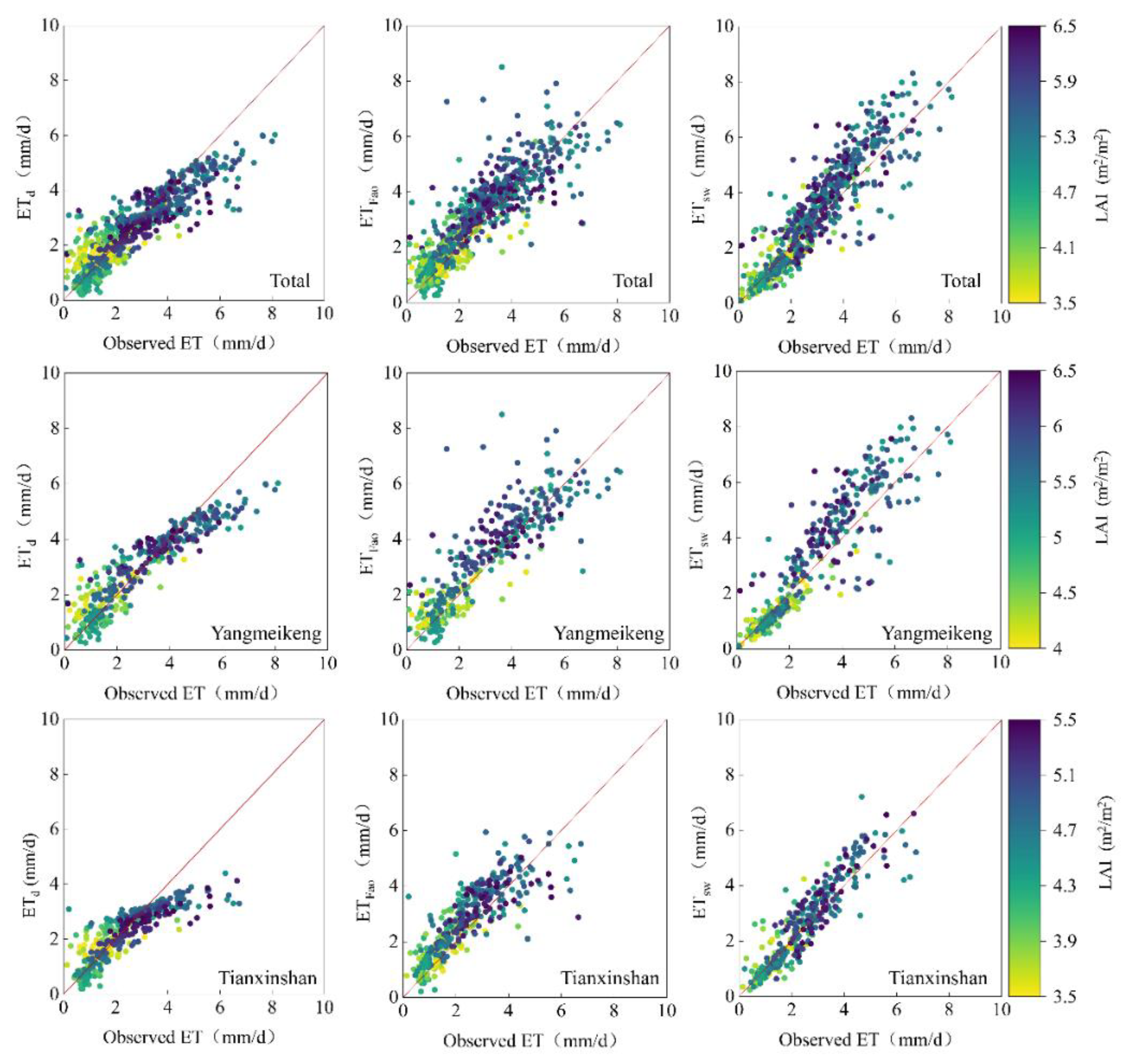


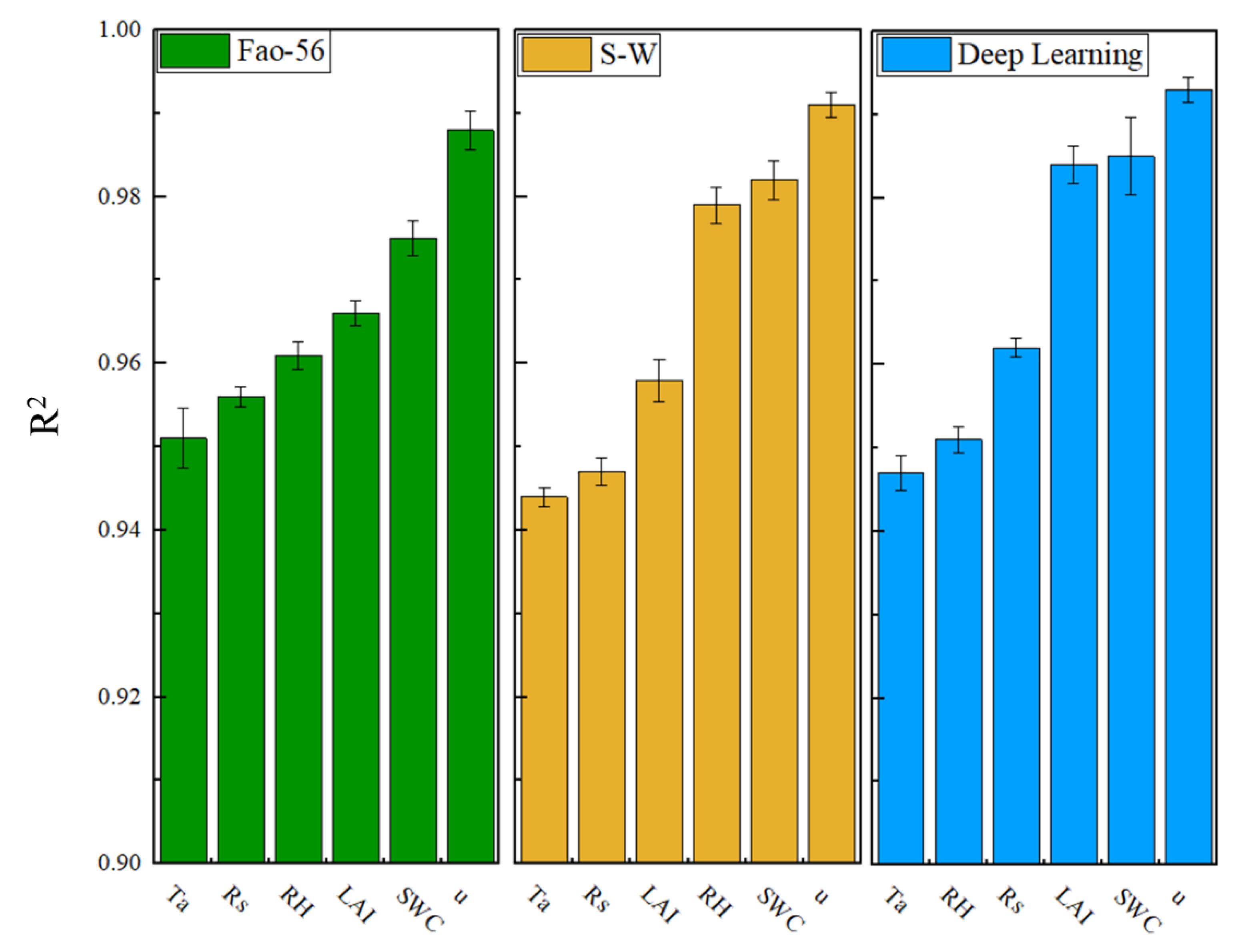
| Total | Yangmeikeng Station | Tianxinshan Station | |||||||
|---|---|---|---|---|---|---|---|---|---|
| DNN | FAO-Dual Kc | S-W | DNN | FAO-Dual Kc | S-W | DNN | FAO-Dual Kc | S-W | |
| R2 | 0.73 | 0.69 | 0.71 | 0.74 | 0.77 | 0.74 | 0.7 | 0.68 | 0.75 |
| RMSE (mm/day) | 0.74 | 0.81 | 0.75 | 0.72 | 0.66 | 0.73 | 0.76 | 0.82 | 0.59 |
| MAPE (%) | 4.66 | 5.71 | 4.93 | 4.17 | 3.66 | 4.23 | 5.08 | 7.21 | 4.06 |
| bias (mm/day) | 0.26 | 0.29 | 0.27 | 0.24 | 0.22 | 0.25 | 0.27 | 0.31 | 0.23 |
| Total | Yangmeikeng Station | Tianxinshan Station | |||||||
|---|---|---|---|---|---|---|---|---|---|
| DNN | FAO-Dual Kc | S-W | DNN | FAO-Dual Kc | S-W | DNN | FAO-Dual Kc | S-W | |
| R2 | 0.81 | 0.75 | 0.78 | 0.83 | 0.87 | 0.84 | 0.77 | 0.66 | 0.78 |
| RMSE | 0.17 | 0.25 | 0.19 | 0.16 | 0.09 | 0.14 | 0.23 | 0.28 | 0.18 |
| MAPE (%) | 3.46 | 4.94 | 4.44 | 3.36 | 3.17 | 3.22 | 4.51 | 6.12 | 3.72 |
| bias | 0.1 | 0.15 | 0.12 | 0.09 | 0.05 | 0.07 | 0.13 | 0.19 | 0.11 |
Disclaimer/Publisher’s Note: The statements, opinions and data contained in all publications are solely those of the individual author(s) and contributor(s) and not of MDPI and/or the editor(s). MDPI and/or the editor(s) disclaim responsibility for any injury to people or property resulting from any ideas, methods, instructions or products referred to in the content. |
© 2023 by the authors. Licensee MDPI, Basel, Switzerland. This article is an open access article distributed under the terms and conditions of the Creative Commons Attribution (CC BY) license (https://creativecommons.org/licenses/by/4.0/).
Share and Cite
Chen, H.; Zhou, Z.; Li, H.; Wei, Y.; Huang, J.; Liang, H.; Wang, W. Evaluation the Performance of Three Types of Two-Source Evapotranspiration Models in Urban Woodland Areas. Sustainability 2023, 15, 9826. https://doi.org/10.3390/su15129826
Chen H, Zhou Z, Li H, Wei Y, Huang J, Liang H, Wang W. Evaluation the Performance of Three Types of Two-Source Evapotranspiration Models in Urban Woodland Areas. Sustainability. 2023; 15(12):9826. https://doi.org/10.3390/su15129826
Chicago/Turabian StyleChen, Han, Ziqi Zhou, Han Li, Yizhao Wei, Jinhui (Jeanne) Huang, Hong Liang, and Weimin Wang. 2023. "Evaluation the Performance of Three Types of Two-Source Evapotranspiration Models in Urban Woodland Areas" Sustainability 15, no. 12: 9826. https://doi.org/10.3390/su15129826
APA StyleChen, H., Zhou, Z., Li, H., Wei, Y., Huang, J., Liang, H., & Wang, W. (2023). Evaluation the Performance of Three Types of Two-Source Evapotranspiration Models in Urban Woodland Areas. Sustainability, 15(12), 9826. https://doi.org/10.3390/su15129826







